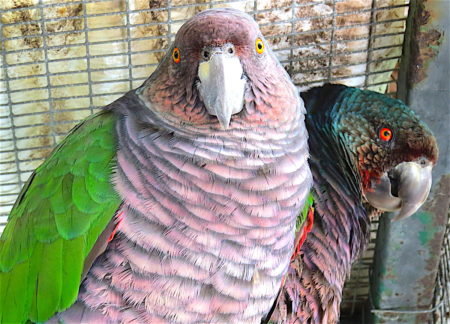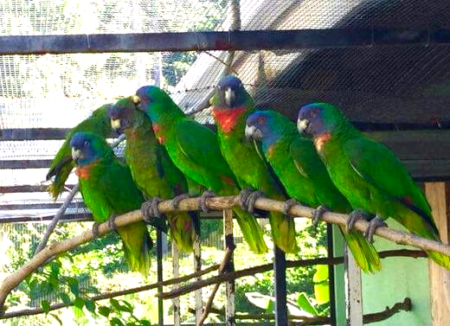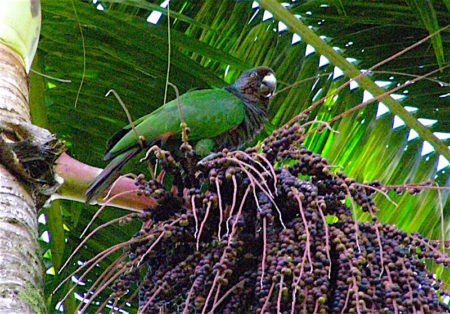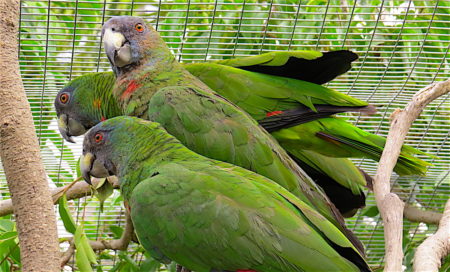The Parrots Were in Good Condition

The parrots in question were wild-hatched and most were rescued after Hurricane Maria. They were being rehabilitated in an aviary operated by the Forestry, Wildlife and Parks Division of the Ministry of Agriculture in Dominica, with the support of Rare Species Conservatory Foundation (RSCF) and International Fund for Animal Welfare (IFAW). BirdsCaribbean understands that the birds were in very good condition—four had recently been released back into the wild. It was expected that the remaining Jaco parrots would also soon be ready for release, where they would have made an important contribution to the survival of the remaining populations.
While there is no doubt that disastrous events like hurricanes pose a serious threat to the persistence of endangered species, there is evidence that both species are resilient and recovery in the wild is possible. Dominica’s parrot populations were greatly affected but recovered after Hurricane David in 1979. Their survival has been aided by multiple conservation measures taken in Dominica including parks and protective legislation, community outreach and education events, programs to reduce agricultural conflicts, complemented by research and monitoring.
Despite the confidence of local and international experts (who have been working in Dominica with the parrots since 1981) that on-island efforts to support the recovery of local populations would be successful, some politically-appointed individuals within the Government of Dominica, apparently decided to facilitate the export of these parrots as an “emergency measure” to support the establishment of a captive breeding population in Germany by the Association for the Conservation of Threatened Parrots (ACTP).
Conservation Issues for Threatened Bird Species
- Conservation programmes for threatened species should be guided by recovery action planning based on sound science, engagement by all stakeholders, and international laws and guidance.
- Conservation programmes for threatened species should focus firstly on recovery of wild populations in the wild, with captive breeding as a last resort.
- There are many risks associated with captive breeding, including risks in transport, transmission or exposure to new diseases, acclimation to a new environment, and loss of genetic diversity and natural behaviors. These programs must be carried out in an extremely careful manner and risks increase if the program is in another country.
- Captive breeding programs can be an effective and important conservation tool (e.g., as shown for the Puerto Rican Parrot), but they must be based on sound science, be proposed and vetted transparently to the conservation community, and wherever possible, be in the country of origin.
- Threatened species programs must involve and empower to the maximum extent possible the local organizations and communities who are ultimately the stewards for the species.

BirdsCaribbean suggests that there are legal, scientific and ethical reasons to question the export of Sisserou and Jaco parrots from Dominica.
The Situation Was Not an “Emergency”
Any argument that the export was justified as an “emergency” action is contradicted by the following:
- All of the exported animals survived the hurricane;
- The female Sisserou at the aviary had lived there for 18 years and successfully reproduced at the aviary in 2010;
- Ongoing parrot surveys reveal that both species’ wild populations also survived the hurricane, with the ecologically common Jaco parrot now widely distributed and some sightings of wild Sisserous; known to be shy and difficult to survey in the wild;
- The aviaries were in the process of being refurbished, with new enclosures, wire and supplies already sent to Forestry;
- The aviary birds were examined and attended to with multiple animal-care teams from IFAW;
- The exported Jaco parrots were being prepared for release into the wild;
- No proposal for emergency action was presented to Forestry, the personnel responsible for animal-care at the aviary, nor ECU.
BirdsCaribbean Supports Dominican Experts, Local Partners

In addition, the scientific authority for CITES in Dominica, the Forestry, Wildlife and Parks Division, was also not consulted about the export—no proposal, conservation plan or agreement was shared with the team in charge of parrot conservation on the island. Instead the arrangements were apparently made in secret and the birds taken without the knowledge or permission of either CITES authority on the island.
Our Dominican partners remain committed to the on-island conservation programs and the protective measures it has developed for its parrots over many years. Thanks to generous donors, BirdsCaribbean has assisted in Hurricane Maria recovery by shipping more than US$12,000 worth of supplies to aid recovery of Dominica’s parrots, including bird feeders, bird seed, tools and field equipment. We have long supported outreach, education and surveys conducted by Dominica’s own experts, who have decades of experience and knowledge. We believe that the conservation of Dominica’s parrots is best done in Dominica by Dominicans, – supported, but not undercut, by foreign entities.
We know that the people of Dominica are resilient and proud of their beautiful birds and in particular, their National Bird, the Sisserou. For this reason alone, the recent removal of these birds from the island calls for far more explanation and justification than has been made public.
What You Can do to Help

1. Share this article with your networks.
